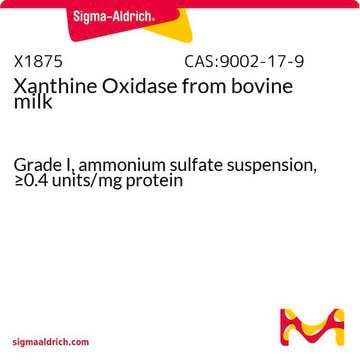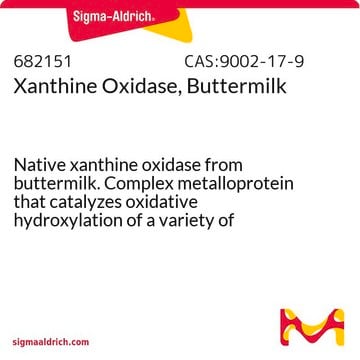All Photos(4)
About This Item
Empirical Formula (Hill Notation):
C5H4N4O2
CAS Number:
Molecular Weight:
152.11
Beilstein:
8733
EC Number:
MDL number:
UNSPSC Code:
41106305
PubChem Substance ID:
NACRES:
NA.51
Recommended Products
biological source
synthetic (organic)
Quality Level
Assay
≥99%
form
powder
solubility
1 M NaOH: soluble 50 mg/mL, clear to slightly hazy
NH4OH: freely soluble
NaOH: freely soluble
SMILES string
O=C1NC(=O)c2nc[nH]c2N1
InChI
1S/C5H4N4O2/c10-4-2-3(7-1-6-2)8-5(11)9-4/h1H,(H3,6,7,8,9,10,11)
InChI key
LRFVTYWOQMYALW-UHFFFAOYSA-N
Looking for similar products? Visit Product Comparison Guide
General description
Xanthine is synthesized from guanine in the presence of guanine deaminase. Xanthine oxidase catalyzes the production of xanthine from hypoxanthine and its subsequent breakdown to uric acid. Xanthine derivatives are present in coffee, tea and cocoa seeds. Xanthine has been proposed as a lead for the generation of pharmacologically active compounds.
Application
Xanthine has been used in a nonradiolabled substrate mix in an Aspergillus nidulans transport assay. It has also been used as a substrate for xanthine oxidase for superoxide anion generation in gill cells and algal cells.
Biochem/physiol Actions
A high level of xanthine is implicated in metabolic disorders like Lesch-Nyhan syndrome. A xanthine-based biosensor may be useful for detecting xanthine in food and clinical samples. Blood and urine samples of patients with renal failure, gout and xanthinuria show high levels of xanthine.
Storage Class Code
11 - Combustible Solids
WGK
WGK 3
Personal Protective Equipment
dust mask type N95 (US), Eyeshields, Gloves
Choose from one of the most recent versions:
Already Own This Product?
Find documentation for the products that you have recently purchased in the Document Library.
Customers Also Viewed
Transport Assays in Aspergillus nidulans
Krypotou E and Diallinas G
Molecular Microbiology, 3(22), 1-5 (2013)
Biosensing methods for xanthine determination: a review
Pundir CS and Devi R
Enzyme and Microbial Technology, 57, 55-62 (2014)
Study on detection methods for xanthine in food and biological samples
Wu S, et al.
Int. J. Curr. Res. Chem. Pharma. Sci, 3(8), 1-5 (2016)
Fish gill damage by the dinoflagellate Alexandrium catenella from Chilean fjords: synergistic action of ROS and PUFA
Mardones JI, et al.
Harmful Algae, 49(22), 40-49 (2015)
D L Krebs et al.
Methods in cell science : an official journal of the Society for In Vitro Biology, 21(1), 57-68 (2000-03-25)
Murine B cell lines such as WEHI-231, BAL17 and M12.4.1 are frequently used as model systems to study signal transduction, cell cycle regulation, and apoptosis. Dissection of these processes often involves expressing exogenous genes in these cells. Electroporation is an
Our team of scientists has experience in all areas of research including Life Science, Material Science, Chemical Synthesis, Chromatography, Analytical and many others.
Contact Technical Service











